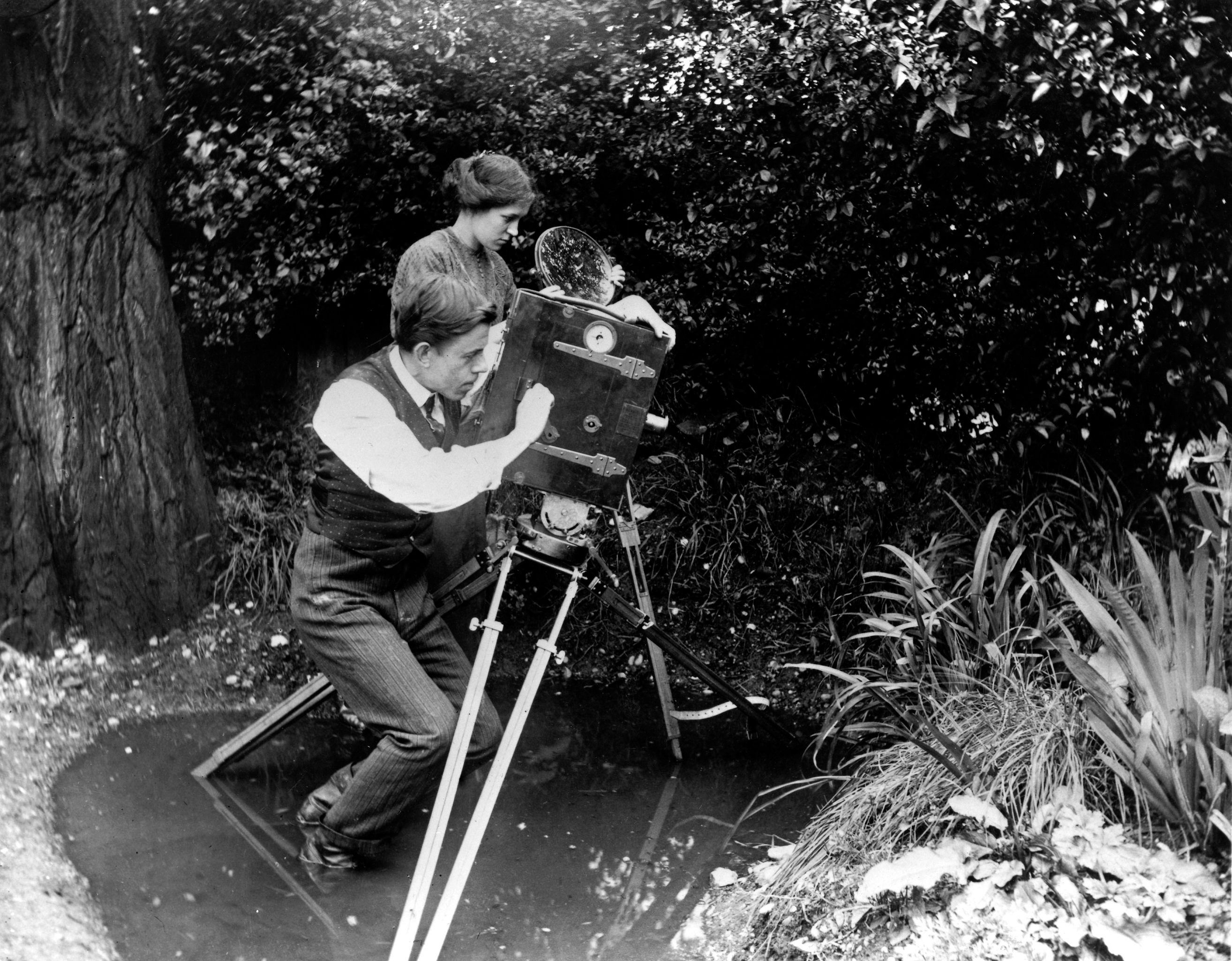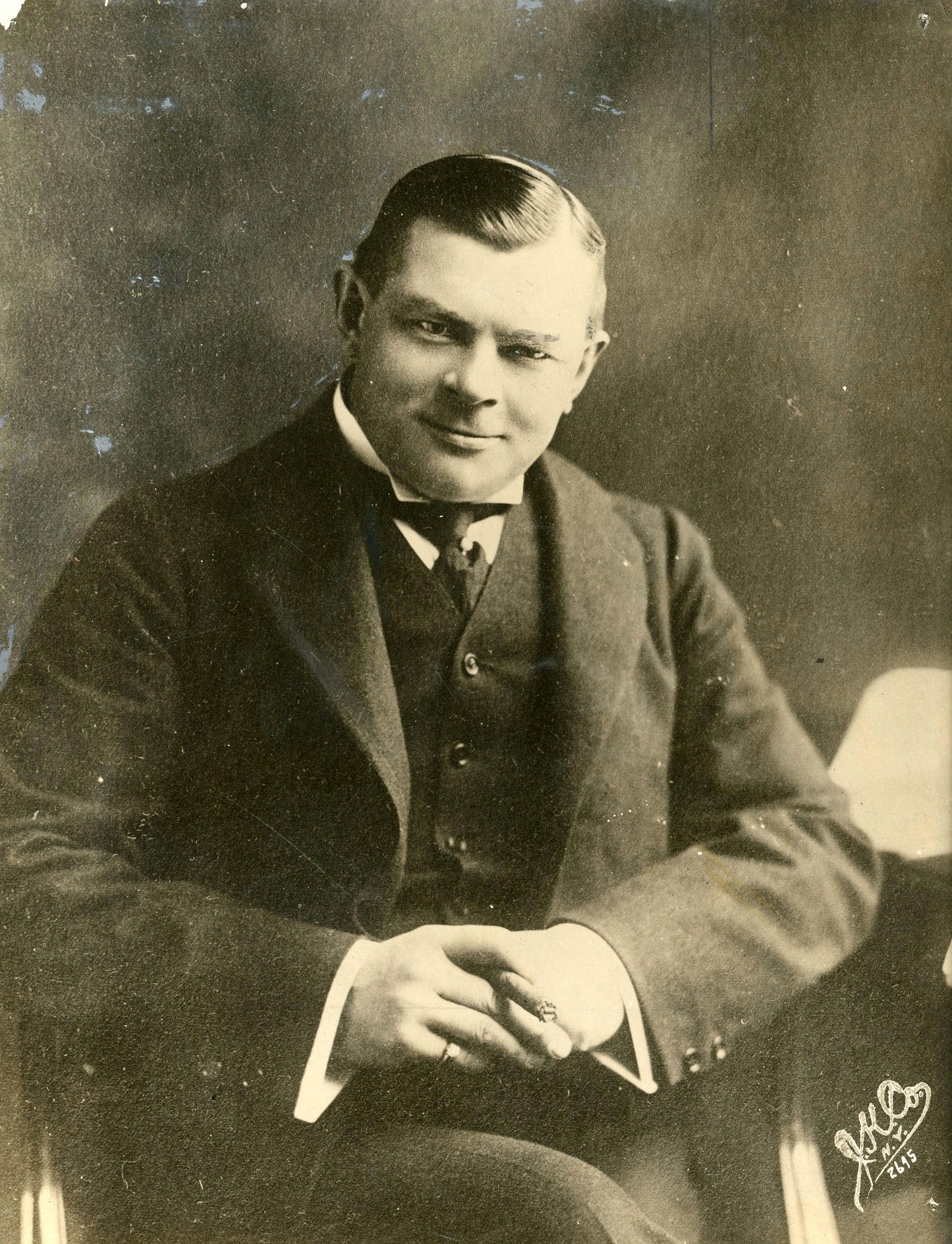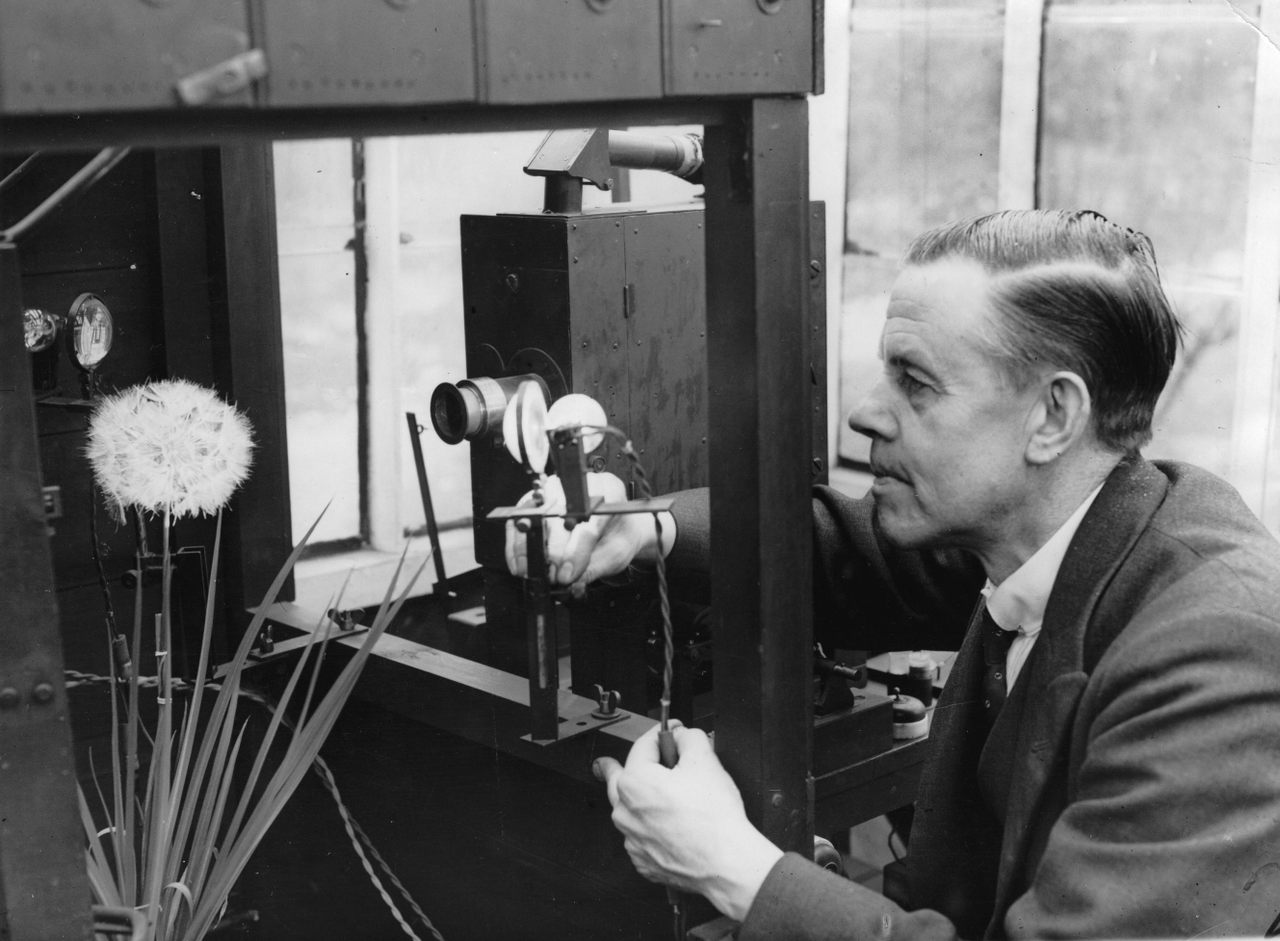The Shy Edwardian Filmmaker Who Showed Nature’s Secrets to the World
F. Percy Smith made flies dance, ants battle, and flowers bloom.
The Balancing Bluebottle wasn’t exactly a hit when it first premiered at the Palace Theatre in London in autumn 1908. The star of this short silent film was a common fly turned circus performer, filmed so closely and clearly you could see the hairs on its body, and projected to monstrous size on the film screen. Stuck on its back to a tiny wooden podium, the fly went through its tricks: Rapidly twirling a matchstick, then a piece of bread, a blade of grass, and finally, a ball twice its size while another fly balanced on top.
It was remarkable—so remarkable that it had to be a trick, viewers concluded. After all, the film was being shown at the Palace, a music hall that went in big for vaudeville-type entertainment, and viewers were used to rudimentary cinema “magic” and special effects.
A month later, on November 11, 1908, the film was presented by its maker, 28-year-old amateur naturalist F. Percy Smith, at a meeting of the Royal Photographic Society. The presentation lent the film the authenticity and a context it lacked in its initial showing at the Palace—it was real, nothing faked, and no insects were harmed in the making—and placed it at the fore of a new kind of cinematic experiment: Using a “cinematograph” to offer access to a previously hidden world of nature. Dozens of reports in the press followed. So, too, did a “fortnight’s nervous breakdown” for Smith, whose shy nature might have been better suited to patiently filming flies glued to miniature podiums than dealing with reporters.
The Acrobatic Fly, the 1910 rerelease of The Balancing Bluebottle and on the only surviving footage from the original film.
The Balancing Bluebottle isn’t something we’d pay to see on an iMax screen now. But at the time, the film represented the cutting edge of what was possible in cinema: Using a hand-cranked camera to turn out magnified images of the previously cloistered worlds of the animals, plants, insects, and even microbial creatures around us. After the juggling fly, Smith further expanded the realm of possibility with more technical innovations, including time-lapse, micro-cinematography, and underwater filming. And as he did, he would set the mold for how modern-day nature and science documentaries look, sound, and feel.
Frank Percy Smith was born in 1880 in Islington, a north London neighborhood then witnessing the flight of the middle class to the suburbs. There are few biographical sources available on Smith, but in 1993, Mark Burgess published a thorough and loving piece on Smith in the Quekett Journal of Microscopy; many of the details here are from his account. From an early age, Smith was a tinkerer—he built his first microscope as a teenager, attaching an eyepiece and an objective to a plant sprayer he found in the garden and using a broom handle as a tripod. His particular interest was in British spiders, and he spent hours collecting them in Epping Forest, a short train journey out of London.
Despite Smith’s attraction to natural history, his family pressured him, an only child, to take a job as a clerk for the Board of Education; he began work at the age of 14. He did it—and even designed time-saving devices, such as a rotary duplicator made from a cocoa tin—but he didn’t like it. When he wasn’t working, he was collecting spiders and examining them under his microscope, or reading up on natural history. In 1899, Smith, 19, joined the Quekett Microscopical Club, founded in 1865 for microscope enthusiasts. Soon after, he was supplementing his small income with lectures, aided by “magic lantern” projections of photographs he took himself.
His first experiments with cinematography began in 1908, all because of a pet fly. According to Burgess’s report, “To abate the crushing boredom of his job, [Smith] befriended a bluebottle.” The fly was kept on a leash and fed with milk; Smith took an incredibly magnified picture of the fly drinking, its long, spongy tongue absorbing the milk, and showed it around his office. The story goes that one of his officemates showed the picture to Charles Urban, an early film producer and distributor who specialized in what were called “interest” films, factual films about interesting topics. In May 1908, Urban lent Smith a cine-camera and two rolls of 35mm film, and said, “Show me what you can do.”
Smith came back with footage of dragonflies, wood ants fighting, and ants milking an aphid; he was promptly given another two rolls of film. Now, Smith was working—part-time—for the man who, if he didn’t invent modern, cinematic edu-tainment, certainly did quite a lot to promote it.

“We owe quite a lot of Charles Urban’s particular business acumen, that he saw the scientific side of these spectacular entertainments … It’s representing the world of wonders more or less as a music hall act,” says Dr. Tim Boon, chief curator at the Science Museum of London and author of Films of Fact, a history of science in film.
That cinema, itself a kind of technological marvel, could be used to explain or describe science was an idea present from the very early days of moving pictures, when there was a clear impulse to depict fact rather than fiction. But though travelogues and newsreels had a place in popular entertainment, much of the scientific footage was confined to scientific circles. Urban’s innovation was in realizing that laypeople would be interested as well.
In 1903, he’d exhibited a series of films shot by zoologist and filmmaker F. Martin Duncan at the Alhambra Theatre in Leicester Square, London. The program included the one-minute Cheese Mites, in which a scientific gentleman at lunch discovers, with his handy microscope, a whole world of hairy-limbed, crab-like beasts cavorting on his Stilton. These films necessarily occupied the same physical entertainment space as sentimental songs and bawdy comedy shows—music halls were one of the few places with projectors.

Urban’s partnership with Smith was natural—Smith was himself the product of a self-taught, amateur education in natural sciences. The fly films were Smith’s first release with Urban; Smith later wrote that the fly, that “unconscious little laughter-raiser,” was filmed “as the result of a technical scientific experiment,” an effort to “demonstrate, in the most graphic manner possible, its great strength and power of endurance.” He defended the film, explaining, “A certain element of novelty or humor was often a great assistance” in “introducing educational pictures to the public.”
With Urban’s backing, Smith was well on his way to becoming something unprecedented in his day: A filmmaker. In 1909, Smith began experimenting with stop-motion animation in To Demonstrate How Spiders Fly, featuring a mechanical spider throwing a thread of silk to the wind to “fly.”
His next great achievement was The Birth of a Flower in 1910, a series of time-lapse—which he called “time magnification”—films of tulips, lilies, roses, and others blooming. That year, Smith—now married—left his position at the Board of Education to become a full-time “photographic expert” in “kinematography”, as he was recorded in the 1911 census. Later that year, Smith and his wife moved to Southgate, a semi-rural North London suburb on the verge of a population boom. The move afforded him more space; his studio there was a large conservatory he’d built to the back of the house, filled with his cobbled-together devices and any creatures he might have been filming.
It’s difficult to overstate the challenges Smith faced in getting the footage he was getting with the technology available at the time. His camera was hand-cranked and large, and his extreme close-ups meant that any vibration could ruin a shot. The film stock required intensely bright light, which was often harmful to the sometimes microscopic organisms he was trying to film. Filming underwater, through a glass observation chamber sunk into a pond, was a damp, dirty business. But he was relentlessly inventive. He rigged up alarms to his time-lapse devices to tell him when to change the film or if something had gone wrong. He was proficient and imaginative in animation—in one 1912 film, he used modeling clay and stop motion to make a lizard melt into a boot. He was patient with recalcitrant animals, but not above poking a porcupine with a stick to get it to show its quills, pushing a badger off a rock wall, or setting a ferret on a small snake, as a test reel shows. And he was persistent, trying for months, even years, to capture the bud opening, the otter catching a pike, the microscopic worlds of organic life hidden in pond water.
But then the war came and cinema-goers had less time for nature. Smith was drafted as a cameraman for the Royal Naval Air Service, eventually filming the surrender of the German fleet from an airship. Even after the war, there wasn’t a lot of call for his work; Urban, who was American, had since moved back to New York. So when Harry Bruce Woolfe, a film producer and businessman, came calling, Smith jumped on board. Woolfe’s company, British Instructional Films, was regularly turning out “interest” films about the recent war, travel, science, and nature; in 1922, Woolfe launched the Secrets of Nature series, short films dedicated to subjects like the life cycle of the newt or insect “infants.” He approached Smith in 1924 to handle insects, aquatic, botanical, and microscopic subjects.
Smith dusted off his machines and got to work. One of his first releases with Woolfe’s outfit, Battle of the Ants, was a staged battle between two nests of wood ants, set up by the Royal Zoological Society. “It was like watching a football match between several thousand players all wearing the same jersey,” Smith recalled. The film was typical of the work Smith would do for the Secrets series: Tightly focused and suffused with a gentle wit and clear affection for his subjects. “He’s got this great line, ‘If anyone ever calls something a pest, then I make a film about it and it becomes beautiful,’” says Dr. Oliver Gaycken, film studies professor at the University of Maryland and author of Devices of Curiosity, about the development of science films in early cinema. “He’s got this kind of devotion to the ugly, the overlooked, and his basic thesis is that the act of filming requires an act of understanding, which makes you love the thing.”
Smith’s devotion to his craft is underscored by the fact that most of his films were shot in his home; his conservatory studio had long since expanded to take up much of the house. The garden was choked with weeds, his frequent film subjects. Insects were everywhere, inside and out. By the later 1920s, the house was being eaten alive by mold of various kinds. It had started with the plates of rotting food and jars of pond water were everywhere, the stars of whatever he was filming; the mold spread, eventually stripping the paint and paper off one whole wall and never fully leaving the drawing room. This became a problem by the end of the decade: His reputation as a cinematic scientist, buoyed by Secrets of Nature, was enough that visiting dignitaries and important people wanted to visit him in his lab and studio. The executives at British Instructional Film, however, aware of the squalor, constructed a fake set for Smith at their studios.
By the end of its run in 1933, Smith had made a third of the 144 Secrets of Nature films, meaning that though he was not the only nature filmmaker, his style of film was fairly influential. His films were in many ways typical of the way nature and wildlife documentary worked then and, some would say, works now. In Battle of the Ants, for example, the titular battle was staged for the benefit of viewers; it would not have happened without intervention by the filmmaker and scientists. While Smith’s work was patiently observational, he was also aware that there needed to be some action—the ants needed to be doing something, we want to see the porcupine’s quills or the ferret take down a snake.
To what degree Smith was responsible for the jocularly anthropomorphizing commentary that accompanied his Secrets of Nature films is unclear; more likely, it was written by producer and editor Mary Field. But he was certainly party to the effort to humanize organisms. This is perhaps best illustrated in his 1931 film, Magic Myxies, a title he came up with after recognizing that a film about myxomycetes, a peculiar, seemingly sentient eukaryotic organism also known as “slime mold,” would need all the help it could get. On discussing the reproductive activities of the “myxie,” the narrator, in plummy, chummy tones, says, “If the Myxie has been so bad tempered that it has failed to find a partner, it is not allowed to become one of the party, but is eaten up. This is a far greater encouragement to matrimony than any tax on bachelors!”
The audience’s expectations of what a film about nature should look like were now set, especially given how popular the series proved to be with audiences and therefore distributors. The Secrets of Nature formula, however, relied on and perpetuated some problematic elements, many of which remain today.
“Unfortunately, in some ways, the manipulation of reality in nature films, with animals in wildlife films, hasn’t really disappeared,” says Professor Larry Engel, a wildlife and nature documentary filmmaker with more than 250 films to his credit and a professor at American University’s film school. “That’s not only disrespectful and unfair to that species, the shark, the porcupine, the tarantula, but it’s also immoral vis-à-vis the viewer, because you’re misleading, you’re lying.” Similarly, the inclination to anthropomorphize, to project human emotions and motivations onto animals, has also not gone away. “That’s where Percy’s generation came from, from sort of an environmental imperialism,” Engel says. “That’s where our industry is, sadly. Not much has changed.”
Smith’s work was the start of a thread that winds through modern-day nature and wildlife documentaries, how we expect them to look and sound like, the sorts of stories they tell—and, perhaps more positively, their mission. Smith wanted to use new technology to make natural science accessible to everyone, to make it astonishing and exciting. “I have always endeavored to administer the powder of instruction in the jam of entertainment,” Smith later said. In that, he certainly succeeded.
Despite his quasi-celebrity status, very little is known about Smith’s private life. “There’s a kind of psychological portrait that I’ve sort of glimpsed the little chunks of that is quite touching. Somebody who was sensitive, shy, who devoted his time and attention to these things that most people would not find interesting or valuable at all,” Gaycken says.
But in the 1930s and ‘40s, Smith was plagued by an intermittent illness; it was quite possibly depression. He seemed to feel himself to be a person out of place in time. “The world now sacrifices everything to speed; quiet seems to be regarded as a detestable condition to be expurgated by any means which applied science can devise,” Smith wrote in the 1930s, “and this state of affairs does not encourage the production of the type of individual who can satisfy himself in an investigation of the hidden beauties of Nature.”
On March 24, 1945, Frank Percy Smith died. The potted biography on the back of See How They Grow, the book that accompanied his film series on plants’ life cycles, claimed that he had been killed in wartime bombing. This is false: Smith, according to the judgement of the coroner, put his head in the gas oven in the kitchen of his Southgate home and killed himself “whilst the balance of his mind was disturbed.” Smith was survived by his wife, Kate, and their daughter, but his reputation as one of Britain’s foremost cinematic scientists barely lasted a generation. His technical innovations were largely adopted by other cinematographers, but without tacit acknowledgement of who’d made them; the machines themselves were lost. His name was largely forgotten.
Smith is only now receiving the attention that he deserves for his contributions to science and nature filmmaking, attention he didn’t seek out in his lifetime. “His legacy has not been properly evaluated and will continue to grow … because there’s a lot of information about him that still hasn’t been evaluated, brought to light,” says Gaycken. “We’ll have to wait.”
Nineteen films of the Secrets of Nature series, including some of Smith’s, were released on DVD in 2010 by the British Film Institute (although not, sadly, to a major sales windfall). In 2013, the BBC aired Edwardian Insects on Film, a look at Smith’s life by a modern-day documentary filmmaker trying to recreate Smith’s iconic bluebottle footage (no flies were harmed in the making of his film). That same year, Tim Boon participated in a half-hour BBC radio program on Smith. This year, Minute Bodies, an edit of Smith’s films put to a musical score by Tindersticks frontman Stuart Staples, will be making the film festival circuit.
Whatever Smith’s legacy turns out to be, it is clear that without him, modern wildlife and nature documentary could look very different. “We wouldn’t have the same natural history television if Percy Smith hadn’t been making those films between the two world wars,” says Boon. “What we would have, Lord knows.&rdquo





















Follow us on Twitter to get the latest on the world's hidden wonders.
Like us on Facebook to get the latest on the world's hidden wonders.
Follow us on Twitter Like us on Facebook